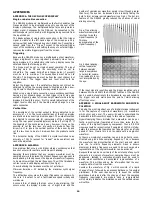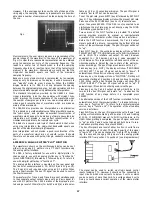
14
Selecting FAST update cancels any waveform processing
functions that have been selected including GAIN
VARIABLE, ADD B, INV, RUN AVERAGE and SEARCH.
Indexed Waveform Memories
(Start with the DSA reset and the generator set to SINE, 20kHz,
5V pk-pk.)
The DSA524 has 16 non-volatile indexed waveform memories.
These memories are each 1K words in size and are used to save
and recall waveforms from Trace A or Trace B.
1.
Press the SAVE(NN) key on Trace A, note that the ENTER
lamp flashes within the numeric keypad section. Press key
0 followed by key 1, this stores the waveform currently
displayed on Trace A into memory 01. Note that the
screen shows "MEMORY 01 = TRACE A" and that RUN
/HOLD is set automatically to HOLD.
2.
Now press RCL(NN) on Trace B, followed by key 0,
followed by key 1, this recalls the waveform onto Trace B.
Note that the screen shows "TRACE B = MEMORY 01" and
that the MEM lamp (in the Trace B area) illuminates in
place of the CH2 lamp.
3.
Set RUN /HOLD back to RUN, and change the generator
frequency. Note that Trace B is now displaying a reference
waveform which can be used for on-screen comparison
with the CH1 signal. Operate the Trace B invert and gain
variable functions, note that these operate on a recalled
waveform just as they do on a waveform sourced from an
input channel.
4.
Press the Trace B RCL(NN) key twice and note that
"TRACE B = MEMORY 01" is displayed again, allowing the
user to check which memory is being displayed at any
time. Press the CH2 key on Trace B to return to a display
of CH2.
The 16 memories are numbered 01 through to 16. They can only
be used to store the contents of a trace memory (i.e. a waveform
displayed on the screen). Recalled waveforms are not affected by
the SEARCH function.
Cursor Measurement
(Start with the DSA reset and the generator set to SINE, 20kHz,
5V pk-pk.)
The DSA524 incorporates cursor measurement with on-screen
digital readout of voltage and time difference. Cursor measure-
ment can only be performed in HOLD, and on only one channel
at a time. The cursor line starts at the left hand edge of the
screen and intersects with the waveform at the reference cursor
point. It is then shifted upwards away from the trace, continues
sideways and then comes down to intersect with the waveform
again at the delta cursor point before continuing to the right
hand edge of the screen. The measurement is made between the
two cursor points.
1.
Press CURS ON/OFF (key 4), Trace B will turn off and a
flashing cursor line will be displayed. Note that RUN/
HOLD is set to HOLD and that the screen shows the
message "Delta A = XX.XV XXX.XuS" representing the
voltage difference and time difference between the two
points.
2.
Try moving each of the cursors using the arrow keys
marked REF CURS and A CURS. Note that the cursor
points "track" the waveform automatically and that the
cursor movement speeds up when the keys are held de-
pressed.
3.
Press CURS A/ B (key 5), Trace A will be replaced with
Trace B. Note that the cursor points adjust automatically
to the new waveform. Press CURS ON/OFF again to turn
cursor measurement off.
Averaging
(Start with the DSA reset and the generator set to SINE, 20kHz,
5V pk-pk.)
The DSA524 can average any number of readings from 2 up to
255, enabling large improvements to be made to the signal to
noise ratio of noisy signals. The average number is initially set
to 16.
1.
Turn off Trace B and note the waveform amplitude on
Trace A. Then remove the trigger signal by setting the
source to EXT. The waveform should now be
unsynchronized, this simulates random noise because
the phase of the signal is now random.
2.
Press the RUN AVERAGE key (within the timebase sec-
tion), the indicator lamp will illuminate to show that
averaging has been selected. The screen will show the
message "AVERAGE COUNT = X" where X increments
continuously between 001 and 016. Note that the trace
is updated each time the message reaches 016 and that
the signal amplitude has been reduced, typically by a
factor of four (truly random noise is attenuated by the
square root of the number averaged). Set the DSA to
HOLD and press SINGLE, note that averaging is
performed once only.
3.
Now press SHIFT (key 8) followed by SET AVG (key 4),
the message "AVERAGES = 016" will be displayed
showing the current setting. Now try using the REF
CURS arrow keys to increment or decrement the
number. Set it to 064 and press ESCAPE to terminate
set-average mode. Re-start averaging, note that the
signal amplitude is now reduced typically by a factor of
eight instead of four. Use SET AVG again to set the
averages back to 16.
The above mode of operation is known as a totalising
average because the screen is only updated when the
total number of digitisings have been averaged. An
alternative mode is a running average whereby the
screen is updated each time digitising takes place.
4.
Return the trigger source to CH1. Press RATE, the SLOW
lamp will illuminate. When SLOW and RUN AVERAGE are
both illuminated the mode is set to running average.
Press SINGLE, note that the screen is updated with the
new average value on every count. Note that averaging
can be stopped at any time by pressing RUN/HOLD.
Averaging is not available in ROLL mode and only a
totalising average is available in RPT mode. In RPT
mode the average number is only displayed each time
averaging is completed.
Dot Joining and Interpolation
(Start with the DSA reset and the generator set to SINE, 20kHz,
5V pk-pk.)
The DSA524 is initialised to use analog dot joining. This links
the 1024 individual sample points on the screen with angled
lines to simulate one continuous line. This gives a display which
is easy to view, and reduces the number of samples per cycle
required to avoid visual aliasing.
However, when the vertical separation between adjacent
sample points is large, dot joining can reduce the peak
amplitude of the waveform. To avoid this a "dots" display can
be selected instead of a "line" display. A dots display also has
the advantage that the exact position and level of each sample
point can be viewed.
1.
Set the generator to SINE, 20kHz (with the DSA at
20us/div) and turn on sweep magnify on the display
oscilloscope. Press SHIFT followed by DOTS (key 7),
note that the individual sample points are now visible.
2.
Turn off the sweep magnifier and note that the display
shows some visual aliasing. Return to a "line" display by
pressing LINE (key 7), note that the visual aliasing is
reduced.
























